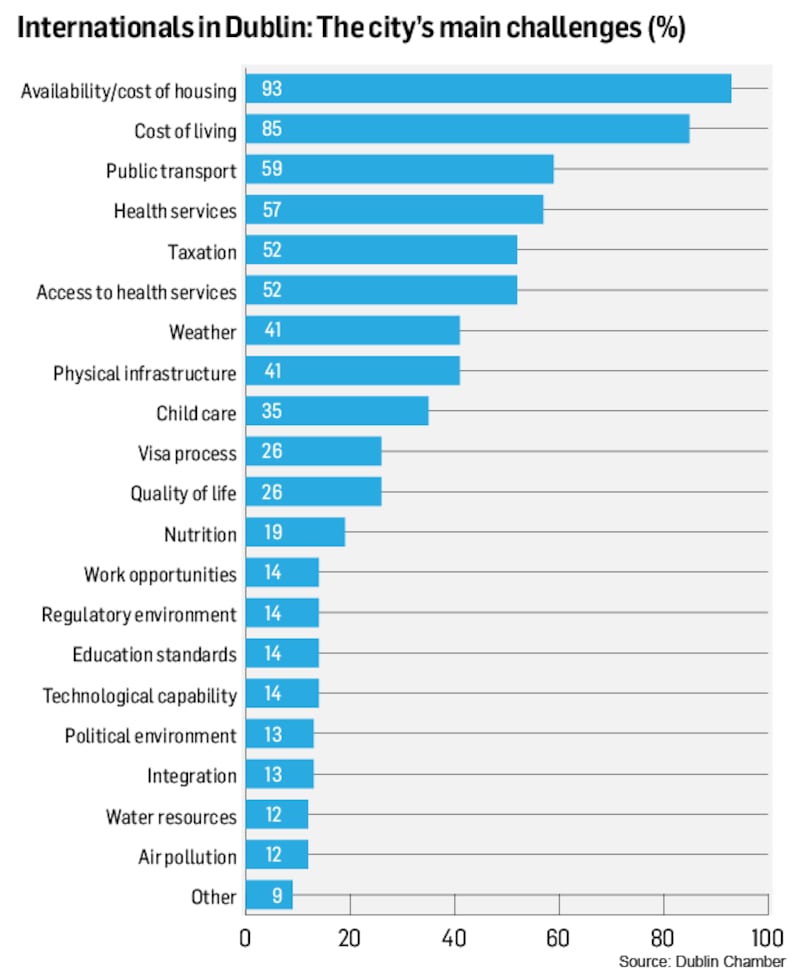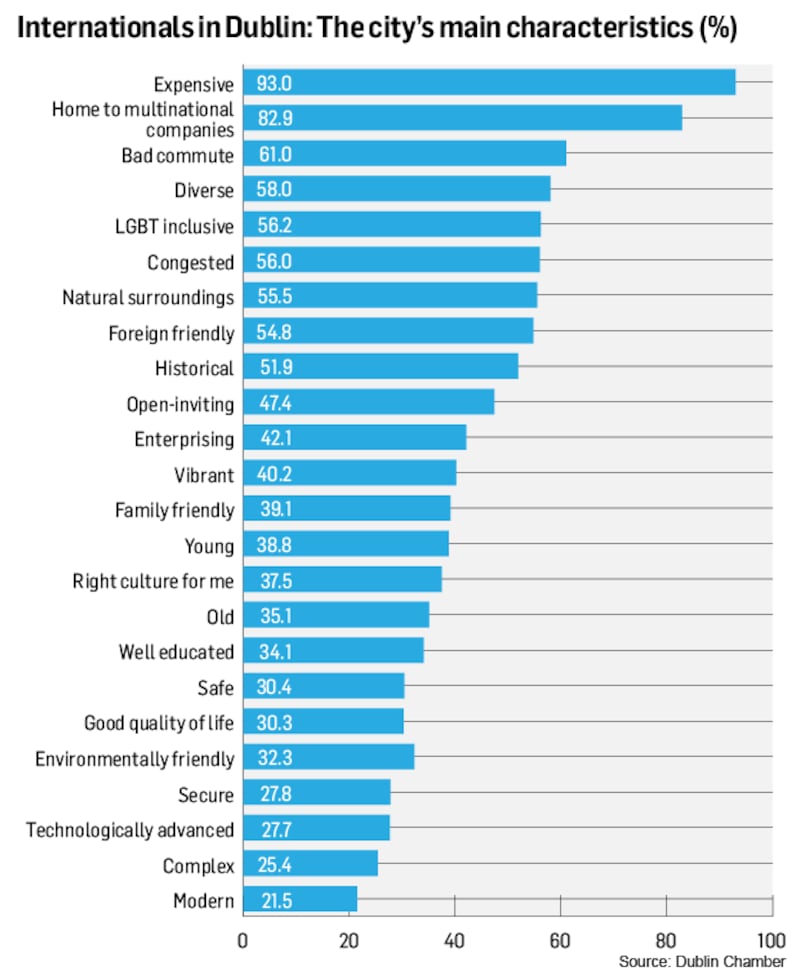It’s not a surprise. When foreign workers living in Dublin were asked to identify the city’s main characteristic, most of them reached immediately for one word: “Expensive.”
When asked to pinpoint the main challenges associated with living in Dublin, they most frequently highlight the availability and cost of housing, the cost of living and the state of the public transport network.
These less-than-flattering answers are contained in one of two recent surveys carried out by Dublin’s Chamber of Commerce, details of which are published in The Irish Times on Saturday.
At the start of the year the Chamber set out to find what the international community, both abroad and at home, thought of dear old Dublin.
This follows its Great Dublin Survey in 2017, which asked Dubliners what they thought about their city and what their hopes and ambitions for it were. A separate study the following year looked at what Cork, Galway, Waterford and Limerick wanted for and from their capital.
Is Dublin beautiful? Is it safe? Is it run by well-respected leaders? Does it have adequate transport and communications infrastructure and good public services? Is it expensive? Would you recommend someone else live in the city? These were among the questions asked and answered.

It was, perhaps, a tale of two cities. Many of those who took part in the research extolled Dublin’s virtues as a beautiful, historical, friendly and fun place, while others bemoaned the high prices and poor quality of life.
As well as surveying almost 1,000 people from overseas living in Ireland, the survey, carried out in June and July, sought the views of more than 5,000 others in 10 countries: the UK, the US, France, Sweden, Canada, India, China, Germany, Australia and Spain.
While “the perceptions of the city from afar are, of course, important, the lived experience of internationals resident in the city is perhaps of greater significance,” the report says.
“Their views of the city are communicated to colleagues, friends and family in their home countries and other locations and will play a key role in shaping opinions of Dublin in future years,” it continues.
When asked to name the main characteristic of the city, 93 per cent of respondents who live here said “expensive”. In second place, on 82.9 per cent, was Dublin as the home to multinational companies.
In third place, on 61 per cent, was the damning phrase “bad commute”. “Congestion” wasn’t far behind.
Just 38 per cent said they thought Dublin had the "Right culture for me" while fewer than one in three said they thought Dublin was "Safe" or had a "Good quality of life"
When asked what aspects of living in Dublin they believe to be most challenging, respondents identified the availability and cost of housing as the biggest challenge, followed by the cost of living and then public transport.
As a place to visit, the cohort gave Dublin a score of 82.4 out of a possible 100. The city also ranked high as a place to organise a conference or event and as a place to work.
But when asked to score the city as a place to actually live, the score fell to 61.4. “The fact that this was given by people living here suggests a degree of dissatisfaction with their experience of the city,” the report says.
Just 38 per cent said they thought Dublin had the “Right culture for me” while fewer than one in three said they thought Dublin was “Safe” or had a “Good quality of life”. A further one in seven said they believed Dublin was “not safe”.

Those are the views of people from overseas who live in the Irish capital. But about those who live abroad and may or may not have even visited Ireland.
Participants from other countries were asked to name the main characteristics that came to mind when they thought about Dublin.
Topping the list were “historical”, “natural surroundings”, “open and inviting”, “foreigner friendly”, “vibrant”, and “good quality of life”. Fortunately for Dublin, the more negative aspects of city life mentioned, namely “Bad Commute” and “Congested”, were ranked lowest and finished behind sunny.
The low scores given for commuting and congestion may simply reflect the fact that people abroad do not experience peak-time congestion in Dublin, the report acknowledges.
While people living overseas may be unfamiliar with the joys of the M50 on a wet October evening, they are strikingly aware of other problems the city struggles with.
When asked what aspects of living in Dublin they believe to be most challenging, respondents overseas ranked “Cost of living” at number one, followed by “the weather", and "availability and cost of housing”.
And which country has the most positive view of Ireland? People in the UK rated Dublin highest, scoring it 83.6 out of 100. “It is a beautiful city”, “offers a wide range of experiences” and “offers a safe environment for visitors and residents”, they said. The main characteristics cited were “historical” and “vibrant” while the chief challenges were “cost of living” and “availability and cost of housing”.
'Beauty of the city', 'wide range of appealing experiences' and 'adequate infrastructure for transport, communications and public services' were top for Chinese respondents
Dublin is also popular in France, where people gave it a score of 80.7. The strongest scores went to the “beauty of the city” and a “safe environment for visitors and residents”. Top characteristics were “right culture for me” and “vibrant”, and the main challenges were “weather”, “availability and cost of housing” and “cost of living”.
There was good news from Australia, too, where Dublin was given a score of 79.5, with the “beauty of the city”, the “wide range of appealing experiences” and the “safe environment” for visitors and residents the top three attributes.
Its main characteristics, as seen from down under, were “historical” and “old”, while chief challenges were “weather”, “cost of living”, and “work opportunities”.
US residents gave Dublin 73.3 points, while the city was awarded 66 points by the Chinese. “Beauty of the city”, “wide range of appealing experiences” and “adequate infrastructure for transport, communications and public services” were the top attributes for Chinese respondents.
Interestingly, among Chinese interviewees, “well educated” was the top characteristic, followed by “natural surroundings” and “historical”. The top challenges were “quality of life”, “work opportunities” and “integration”.

Dublin compares reasonably well with other cities around the world when it comes to overall reputation, scoring better than Seattle, Boston and Barcelona but behind San Francisco, Toronto, London, Copenhagen and Sydney.
Among the measures the chamber says are needed for the improvement of quality of life in the city are: a new cultural quarter; the building of the MetroLink; 2,400km of cycle paths; a dramatic expansion of bike-sharing schemes; and the delivery of 230km of continuous bus priority lanes under BusConnects.
It is also says that at least 14,000 new homes need to be built each year and that there should be an increased delivery of apartments, to reflect smaller household demographics. It also advocates an additional 750 frontline gardaí for Dublin and smart city street lighting to be implemented.
"The findings show that Dublin's overall reputation is strong," says Niall Gibbons of the Dublin Chamber. "There's a lot in the report to take heart from. The fact that Dublin is viewed from outside as a beautiful and open city is hugely welcome. Internationals also recognise the important of Ireland's history."
More than half of our international community have a negative opinion of our congested city infrastructure
Gibbons says issues connected with housing and infrastructure are “well known by those living abroad” and the findings serve as “another timely reminder of the importance of us being able to solve our accommodation issues and to vastly improve our over-congested transport network”.
He says Dublin’s reputation as a city “can only be as good as how and where people live. We need 14,000 units per annum compared with the current 7,000 being built. We need a high-density urban core for long-term, sustainable city living.
“More than half of our international community have a decidedly negative opinion of our congested city infrastructure. In the short run, improving Dublin’s cycling infrastructure is something that can be achieved quickly and can have immediate impact on commutes. In the medium term, investment in sustainable and resilient transport systems such as MetroLink and Bus Connects are a must to improve connectivity across the city.”
Gibbons also says it is “concerning that Dublin was seen as safe by just one in seven respondents. At its most basic level, a city needs to be safe for all. In recent times, how safe a city is has risen to become the most important driver of reputation internationally.
“Great cities have public-realm and pedestrian-first policies that encourage life and vibrancy in the city environment. By rejuvenating some of our more neglected city streets we can not only make them more appealing but also much safer in the process.”










